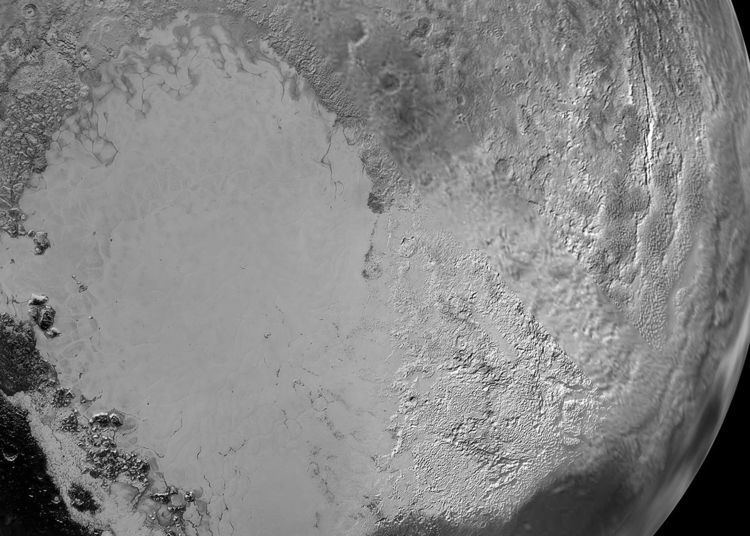Diameter 1,590 km (990 mi) | ||
 | ||
Tombaugh Regio /ˈtɒmbaʊ ˈrɛdʒi.oʊ/, nicknamed The Heart after its shape, is the largest bright surface feature of the dwarf planet Pluto. It is just north of the equator, to the northeast of Cthulhu Regio and to the northwest of Krun Macula, both dark features. Its western lobe, a 1000 km-wide plain of nitrogen and other ices, is named Sputnik Planitia. The eastern lobe is thought to consist of high-albedo uplands coated by nitrogen transported through the atmosphere from Sputnik Planitia, and then deposited as ice. Some of this nitrogen ice then returns to Sputnik Planitia via glacial flow. It is named after Clyde Tombaugh, the discoverer of Pluto.
Contents
Description
Tombaugh Regio is a large, light-colored region about 1,590 km (990 mi) across. The two lobes of the feature are geologically distinct. The western lobe, Sputnik Planitia, is smoother than the eastern, and they are of slightly different colors. Early speculation was that the western lobe may be a large impact crater filled with nitrogen snow. Bright spots within the region were initially speculated to be mountain peaks. Photos, released on 15 July 2015, revealed 3,400 m (11,000 ft) mountains made of water ice in the feature; they also showed no craters in this same region. Subsequent data indicated that the center of Sputnik Planitia is rich in nitrogen, carbon monoxide, and methane ices, and that features near the edges of the region show evidence of ice flow such as glaciers, and light material overlying the darker material at the eastern edge of Cthulhu Regio. The surface of Sputnik Planitia is divided into polygonal convection cells and is less than 10 million years old, indicating that Pluto is geologically active.
The feature had been identified as a bright spot for six decades prior to the New Horizons flyby, although it was impossible to image it with enough resolution to determine its shape. Over these six decades the spot had been observed to be dimming.
Naming
Tombaugh Regio was first identified in the initial image of Pluto returned after the New Horizons probe recovered from an anomaly that temporarily sent it into safe mode. NASA initially referred to it as a "heart" in reference to its overall shape. On 15 July 2015, the region was named "Tombaugh Regio" by the New Horizons team in honor of astronomer Clyde Tombaugh, the discoverer of Pluto, regio being Latin for 'region'. The approval of the International Astronomical Union (IAU) is required before the name "Tombaugh Regio" can become official, but Rita Schulz, chair of the IAU's Working Group for Planetary System Nomenclature, has said the group "could approve this name right away, as we have pre-discussed it."
Some people find the feature also resembles the Disney character Pluto, an animated non-anthropomorphic dog which shares the name of the dwarf planet. The Walt Disney Company acknowledged this perceived likeness in a short animation.
